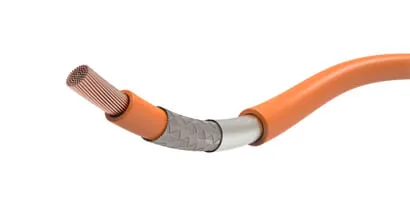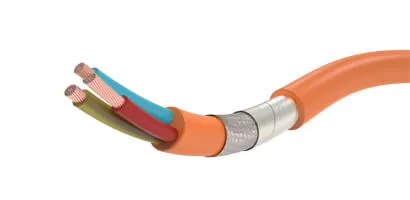Electric vehicle wires and cables play a pivotal role in ensuring the safe and reliable operation of EVs, facilitating the interconnection of various components such as batteries, motors, controllers, and sensors.
_(1).webp)
Operating Temperature: -40°C to +180°C, Class E according to ISO 6722-1
Operating Voltage: 600 VAC / 1000VDC
Insulation: mod. silicone rubber
Approval: ISO 6722-1, LV 216-2

Operating Temperature: -40°C to +180°C, Class E according to ISO 6722-1
Operating Voltage: 600 VAC / 900 VDC, 1000 VAC / 1500 VDC
Insulation: silicone rubber
Approval: ISO 6722-1, LV 216-2

Operating Temperature: -40°C to +180°C,
Operating Voltage: 600 VAC / 900 VDC, 1000 VAC / 1500 VDC
Insulation: silicone rubber
Approval: ISO 6722-1

Operating Temperature: -40°C to +150°C
Operating Voltage: 1000 VAC / 1500 VDC
Insulation: XLPO/EVA, TPE-E
Approval: ISO 6722-1 class D. ISO 19642-9 class D
Purpose: Connect the battery pack to the electric drivetrain, including the motor controller and power inverter.
Features:
High voltage and current carrying capacity.
Thick insulation to withstand high voltage levels (typically 400-800 volts in modern EVs).
Heat-resistant materials to handle power transmission from the battery.
Purpose: Transmit power from the battery or powertrain to the electric motor and inverter.
Features:
High current capacity to handle power demands of the motor.
Heat-resistant insulation capable of withstanding elevated temperatures generated by the motor and inverter.
Flexible design to accommodate movement and vibrations within the vehicle.
Purpose: Connect the vehicle to charging stations or home charging units for charging the battery.
Features:
High voltage and current rating to support rapid charging.
Safety features such as insulation and shielding to protect against electrical faults.
Flexibility for ease of handling during charging.
Purpose: Transmit data and control signals between various vehicle components, including sensors, controllers, and displays.
Features:
Shielding to protect against electromagnetic interference (EMI) and ensure signal integrity.
Multiplexing capabilities to carry multiple signals through a single cable.
Flexible and durable design to withstand frequent use and vehicle vibrations.
Purpose: Provide safety interlock signals between the battery pack and vehicle systems to ensure safe operation.
Features:
Designed to carry low-current signals related to vehicle safety systems.
Robust insulation and shielding to prevent interference and ensure reliability.
Purpose: Connect various sensors throughout the vehicle to monitor parameters such as temperature, pressure, and position.
Features:
Shielding to protect sensitive sensor signals from EMI.
Flexible and lightweight design for installation in tight spaces.
Purpose: Enable communication between onboard computers, control units, and external devices.
Features:
High-speed data transmission capabilities.
Shielding and insulation to protect against EMI and ensure data integrity.
Compatibility with CAN (Controller Area Network) and Ethernet protocols used in automotive systems.
1. Power Distribution:
Battery Pack to Powertrain:
High voltage battery cables transmit power from the battery pack to the electric motor, inverter, and other components of the powertrain. These cables are designed to handle high currents and voltages efficiently.
Powertrain Components:
Motor and inverter cables deliver power from the battery to the electric motor and manage the motor's speed and torque. These cables must withstand mechanical stress and high temperatures generated during operation.
2. Charging Infrastructure:
Onboard Charging Systems:
Charging cables connect the vehicle's charging port to external charging stations or home charging units. These cables support high voltages and currents for rapid charging.
Offboard Charging Stations:
EV charging infrastructure includes cables used in public charging stations and fast-charging networks. These cables must be durable, weather-resistant, and compatible with various charging protocols.
3. Vehicle Control and Communication:
Signal and Control Cables:
Transmit data and control signals between vehicle components, including sensors, controllers, and displays. These cables enable communication for functions such as vehicle diagnostics, traction control, and regenerative braking.
HVIL (High Voltage Interlock Loop) Cables:
HVIL cables provide safety interlock signals between the battery pack and vehicle systems to ensure safe operation. These cables play a critical role in the vehicle's high voltage safety system.
4. Auxiliary Systems:
Heating, Ventilation, and Air Conditioning (HVAC):
Cables are used to power and control HVAC systems in electric vehicles, ensuring passenger comfort and efficiency.
Safety and Infotainment Systems:
Wires and cables support various auxiliary systems, including airbag deployment, lighting, audio systems, and navigation displays.
5. Sensor and Monitoring Systems:
Sensor Cables:
Connect sensors throughout the vehicle to monitor parameters such as temperature, pressure, and battery state-of-charge. These cables enable real-time data collection for vehicle performance optimization.
6. Data Communication:
CAN (Controller Area Network) Bus Cables:
Enable communication between onboard computers, control units, and electronic components. CAN bus cables facilitate data exchange for vehicle diagnostics, monitoring, and control.
7. Vehicle Integration and Assembly:
Wire Harnesses:
Bundles of wires and cables organized into harnesses for efficient integration into the vehicle's electrical system. Wire harnesses simplify assembly and maintenance processes while ensuring proper routing and protection of cables.